
Dr. Mario is a 1990 puzzle video game developed and published by Nintendo for the Nintendo Entertainment System and Game Boy. It was produced by Gunpei Yokoi and designed by Takahiro Harada. The soundtrack was composed by Hirokazu Tanaka.

Final Fantasy IV, titled Final Fantasy II in its initial North American release, is a 1991 role-playing video game developed and published by Square for the Super Nintendo Entertainment System. The fourth main installment of the Final Fantasy series, the game's story follows Cecil, a dark knight, as he tries to prevent the sorcerer Golbez from seizing powerful crystals and destroying the world. He is joined on this quest by a frequently changing group of allies. Final Fantasy IV introduced innovations that became staples of the Final Fantasy series and role-playing games in general. Its "Active Time Battle" system was used in five subsequent Final Fantasy games, and unlike prior games in the series, IV gave each character their own unchangeable character class — although at a few points in the story, a dark knight will choose the path of a paladin, or a summoner will evolve to a new tier of spellcasting.

Mario Kart 64 is a 1996 kart racing game developed and published by Nintendo for the Nintendo 64 (N64). It is the second main entry in the Mario Kart series and is the successor to Super Mario Kart (1992) for the Super Nintendo Entertainment System. It was released in Japan on December 14, 1996, and in North America and Europe in 1997. It was released for the iQue Player in China on December 25, 2003. It was released on the Wii's and Wii U's Virtual Console in 2007 and 2016, and on the Nintendo Switch Online + Expansion Pack on October 25, 2021.

Metroid Prime is a 2002 action-adventure game developed by Retro Studios and published by Nintendo for the GameCube. Metroid Prime is the fifth main Metroid game and the first to use 3D computer graphics and a first-person perspective. It was released in North America in November 2002, and in Japan and Europe the following year. Along with the Game Boy Advance game Metroid Fusion, Prime marked the return of the Metroid series after an eight-year hiatus following Super Metroid (1994).

A Boy and His Blob: Trouble on Blobolonia / Fushigi na Blobby: Blobania no Kiki is a puzzle-platform game developed by Imagineering and published by Absolute Entertainment for the Nintendo Entertainment System (NES). The video game was released in North America in 1989, in Europe by Nintendo in 1991 and in Japan by Jaleco in 1991. A Boy and His Blob follows an unnamed male protagonist and his shapeshifting blob friend on their adventure to save the planet of Blobolonia from the clutches of an evil emperor.

Mario Kart: Double Dash is a 2003 kart racing video game developed and published by Nintendo for the GameCube. It is the fourth main entry in the Mario Kart series. Similar to previous titles, Double Dash challenges Mario series player characters to race against each other on 16 Mario-themed tracks. The game introduced a number of gameplay features, such as having two riders per kart.

Rock n' Roll Racing is a vehicular combat-based racing video game developed by Silicon & Synapse and published by Interplay Productions for the Super Nintendo Entertainment System in 1993 and the Mega Drive/Genesis in 1994. The game prominently features a number of popular heavy metal and rock songs in its soundtrack, hence the game's title. After Silicon & Synapse rebranded into Blizzard Entertainment, a port to the Game Boy Advance was released in 2003. In celebration of the company's 30th anniversary, a new version titled Definitive Edition alongside emulated re-releases of the original game were re-released for Microsoft Windows, Nintendo Switch, PlayStation 4 and Xbox One as part of the Blizzard Arcade Collection in February 2021.

Banjo-Kazooie: Grunty's Revenge is a 2003 platform game developed by Rare and published by THQ for Game Boy Advance. It is the third installment in the Banjo-Kazooie series and takes place between the events of the Nintendo 64 (N64) games Banjo-Kazooie (1998) and Banjo-Tooie (2000). In Grunty's Revenge, the evil witch Gruntilda travels back in time to prevent the events of Banjo-Kazooie from happening, and the bear Banjo and his bird friend Kazooie set out to stop her. Grunty's Revenge retains the focus on collecting items and most of the other game mechanics from its predecessors, but is presented in 2D rather than 3D. Aside from the main game, players can also access minigames such as fishing and target shooting.
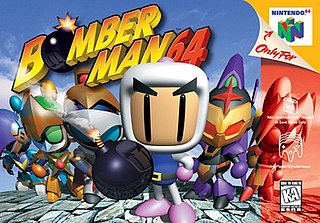
Bomberman 64 is a video game developed and published by Hudson Soft in Japan, and published by Nintendo in North America and Europe for the Nintendo 64. The game was released in Europe and North America in November and December 1997, respectively. While the game never saw a release on the Wii's Virtual Console service, it was released on the Wii U Virtual Console in both Europe and North America in March 2017 followed by Japan in June 2017.

Bomberman Generation is a 2002 video game released for the GameCube. It was followed up by Bomberman Jetters.
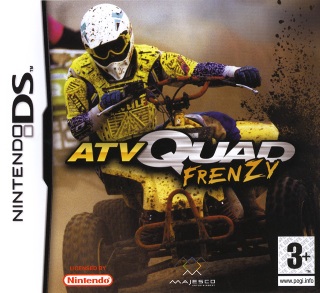
ATV: Quad Frenzy is a 2005 racing video game developed for the Nintendo DS by Skyworks Technologies and published by Majesco Entertainment. It was released for the Nintendo DS handheld games console on November 14, 2005 in North America, on June 16, 2006 in Europe and on October 25, 2007 in Australia. ATV: Quad Frenzy features five different game modes, which all center around ATV racing which takes place in various environments. Reviews of the game were critical; the game garnered only a 35% aggregated score from Metacritic.

Bomberman Jetters is an action game for the Game Boy Advance, GameCube and PlayStation 2, and part of Hudson Soft's Bomberman series. The game builds on the gameplay style established in the previous Bomberman series entry, 2002's Bomberman Generation, and features characters and settings from the 2002 anime series Bomberman Jetters. The GameCube version utilizes cel-shaded graphics similar to those of Bomberman Generation, while the PlayStation 2 version does not.
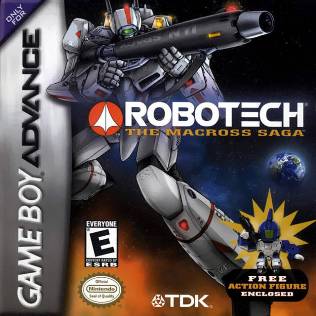
Robotech: The Macross Saga is a side-scrolling shoot 'em up for the Game Boy Advance handheld system, developed by Lucky Chicken Games and published by TDK Mediactive. This title was released during a renaissance of Robotech video games, where struggling projects were no longer cancelled and actually made it to market. A remake was published in 2021, Robotech: The Macross Saga HD Edition.
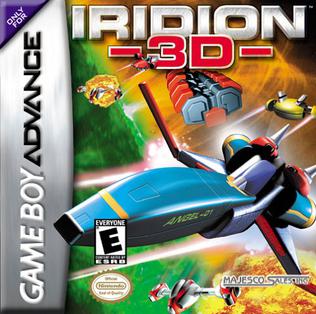
Iridion 3D is a quasi-3D rail shooter video game developed by Shin'en Multimedia. A launch title for the Game Boy Advance portable game console, it was released in North America on June 11, 2001 and in Europe on September 21. The player controls a single starship defending Earth from the alien Iridion. The game spans seven levels from Earth to the aliens' home planet, each following a linear path that culminate with a boss.
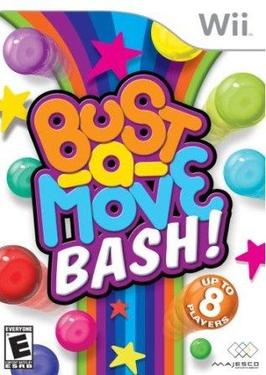
Bust-A-Move Bash!(known in Europe as Bust-A-Move) is a bubble shooter tile-matching video game released exclusively for the Wii, as part of the Bust-A-Move series. It is the first Bust-A-Move game released on a Nintendo console after Bust-A-Move 3000, released in 2003 on the GameCube.

TwinBee is a vertically scrolling shooter released by Konami as an arcade video game in 1985 in Japan. Along with Sega's Fantasy Zone, released a year later, TwinBee is credited as an early archetype of the "cute 'em up" type in its genre. It was the first game to run on Konami's Bubble System hardware. TwinBee was ported to the Family Computer and MSX in 1986 and has been included in numerous compilations released in later years. The original arcade game was released outside Japan for the first time in the Nintendo DS compilation Konami Classics Series: Arcade Hits. A mobile phone version was released for i-mode Japan phones in 2003 with edited graphics.
Star Soldier is a series of scrolling shooters mainly developed by Hudson Soft. Konami has owned the rights to the series since their absorption of Hudson Soft in 2012. The first game, named Star Soldier, appeared on the MSX and NES in 1986, and the series has continued on various gaming systems. Star Soldier itself was released with little change in a compilation for the Super Famicom in 1995, received enhanced remakes for both the GameCube and PlayStation 2 in 2003, and a different remake for the PlayStation Portable in 2005, while the latest installment of the series was released on the Wii as a WiiWare game in 2008. In addition, Super Star Soldier, Final Soldier, Soldier Blade and Star Parodier have been re-released on the Wii's Virtual Console and on the Japanese PC Engine's Best Collection lineup for the PSP. The Star Soldier games are best known for their distinctive music, unique weapon power-ups, and a special time attack high score mode called "Caravan Mode".
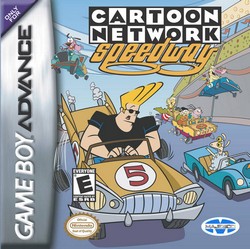
Cartoon Network Speedway is a kart racing video game released for the Game Boy Advance in 2003. Published by Majesco Entertainment and developed by DC Studios, the game features characters from Cartoon Network's original animated television series; Ed, Edd n Eddy, Johnny Bravo, Courage the Cowardly Dog, Cow and Chicken, and Sheep in the Big City.

Super Mario Maker 2 is a 2019 platform game and game creation system developed and published by Nintendo for the Nintendo Switch. It is the sequel to Super Mario Maker and was released worldwide on June 28, 2019. The gameplay is largely retained from that of its predecessor, in which players create their own custom courses using assets from various games across the Super Mario franchise and share them online. Super Mario Maker 2 introduces new features and course assets, including a single player story mode and new level assets based on Super Mario 3D World.

Virtual Fishing is a 1995 fishing video game developed by Locomotive Corporation and published by Pack-In-Video in Japan for the Virtual Boy. The player participates in a series of fishing tournaments at various different locations by catching a large number of fishes with a high average weight under a time limit. Its gameplay consists of two segments and features two additional modes of play.



















